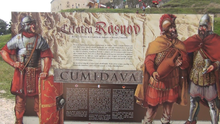Cumidava
 | |
| Alternative name | Comidava, Komidava |
|---|---|
| Location | Dealul Cetății, Grădiște, Roadeș, Brașov, Romania |
| Coordinates | 45°35′26″N 25°28′10″E / 45.590524°N 25.469504°E |
| Site notes | |
| Condition | Ruined |
Monument istoric | |
| Reference no. | BV-I-m-A-11284.02 [1] |
Cumidava (also Comidava, Komidava,
Etymology
After the Roman conquest of Dacia, the Dacian name Comidava was modified by the Latin writers to Cumidava.[2] (It is common in the Late Latin inscriptions to express the letter "o" by "u", e.g. patrunus instead of patronus 'protector', and Latin rumpia instead of Greek ρομφαια (Rhomphaia) 'Thracian claymore / sword'.[3])

The name Comidava is a compound of dava 'town' and "comi". Scholars' opinions about the meaning of the Dacian word "Comi/Cumi" include:
- 'Desire, love'—a word explained by the ancient Iranian Kamya, with an obscure pronunciation of the "a". The term "Comi" is also contained in the name of the Dacian prince and priest Como-sicus[4]
- 'Lovely' (Romanian Drăgănești) [5]
Another town named Comidava / Cumidava was situated in the Remesiana's territory [6]
History
Early references

Early references to Cumidava are made by the geographer
An inscription on stone dedicated to
The archaeological research at Râșnov was initiated in 1856 by Johann Michael Ackner[8] and continued in 1939 by Macrea Mihail who also recorded the presence of Dacian pottery during the digs at the Rasnov Roman camp[9]
The inscription found in 1939:[10][11]
Iuliae Mameae augustae matri Domini nostri sanctissimi Imperatoris Caesaris Severi Alexandri augusti et castrorum senatusque cohors Vindelicorum Piae fidelis Cumidavensis Alexandrianae ex quaestura sua dedicante la sdio Dominatio legato augusti III Daciarum
After Roman conquest, a part of the kingdom of
Cumidava had a military road link with Angustia (now Brețcu), the farthest east of the Roman campus in Dacia.[12]
From a Dacian town to a Roman military castrum
The Roman military
Sinaia lead plates
Cumidava is mentioned also on the controversial
See also
- Dacia
- Roman Dacia
- List of ancient cities in Dacia
- Dacian davae
Notes
- ^ "National Register of Historic Monuments in Romania, Brașov County" (PDF). www.inmi.ro. Archived from the original (PDF) on 9 October 2011. Retrieved 18 October 2012.
- ^ Garbsch 1991, p. 285.
- ISBN 978-1-108-01240-9, page 34
- ^ Tomaschek, W,. "Les restes de la langue dace" in "Le Muséon, Volume 2" edited by "Société des lettres et des sciences", Louvain, Belgium, 1883
- ^ Parvan, V., "Getica", page 398, "Cultura Nationala", Bucharest, Romania, 1926
- ^ Ion I. Russu, Limba Traco-Dacilor: de I. I. Russu. Ediția a 2-a revăzută si adăugită, Editura Științifică, 1967
- ^ L'Année épigraphique: revue des publications épigraphiques relatives a l'antiquité romaine, Académie des inscriptions & belles-lettres (France) Presses Universitaires de France., 1968,
- ^ Johann Michael Ackner (1782-1862): Leben und Werk by Volker Wollmann, the University of Michigan, Dacia, 1982
- ^ The native pottery of Roman Dacia by Mircea Negru, Archaeopress, 2003
- ^ Ion I. Russu in "Inscriptiile Daciei Romane: Volume 3, Part 4", Editura Academiei de Stiinte Sociale si Politice a RSR, Romania
- ^ Fasti archaeologici, Volumes 28-29, International Association for Classical Archaeology, Sansoni Editore., 1973, page 461,
- ISBN 9780807849392, 2000,
- ^ Din tainele istoriei - Misterul tablitelor de plumb, Formula As, n. 649; 2005
References
- Treptow, Kurt W.; Bolovan, Ioan (1996). A history of Romania. East European Monographs; 3rd Revised edition. ISBN 978-0-88033-345-0.
- Dapper, Morgan (2009). Ol' man river : geo-archaeological aspects of rivers and river plains. Academia Press in cooperation with Ghent University, Dept. of Archaeology and Ancient History of EuropeBelgium. ISBN 978-90-382-1404-7.
- Garbsch, Jochen (1991). "The oldest military diploma for Dacia". Roman frontier studies 1989: proceedings of the XVth International Congress of Roman Frontier Studies edited by ISBN 978-0-85989-364-0.
Further reading
- Olteanu, Sorin. "Linguae Thraco-Daco-Moesorum - Toponyms Section". Linguae Thraco-Daco-Moesorum (in Romanian and English). Archived from the original on 16 July 2011. Retrieved 3 January 2010.


